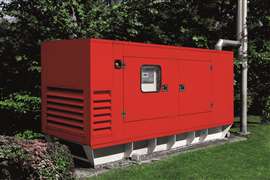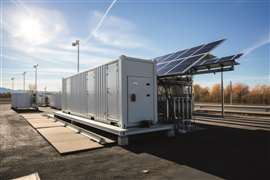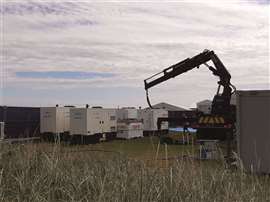Jeff Eisenberg on the Stage V genset rental challenge
06 February 2024
Gensets with Stage V compliant engines are better for the environment, but they are expensive and bring certain challenges for equipment rental companies. Rental consultant Jeff Eisenberg reports for International Rental News (IRN) and Rental Briefing.
Diesel-powered generators have been on construction and other sites for decades, and this will likely continue. The applications include charging electric equipment where the grid can’t yet cope. European Stage V diesel emission requirements create particular challenges for diesel generators. Why is that, and what will it take to improve the situation?
Stage V diesel engines have been required in all new non-road equipment since January 2020 in the European Union. Stage V engines are much cleaner than the first emission requirement Stage I introduced in 1997, and in the case of particulate emissions, 97% cleaner. Diesel engines between 37kw and 560kw have the strictest emission limits, and this range covers many popular generator sizes in the rental industry.
 Jeff Eisenberg
Jeff Eisenberg
USA Tier 4 standards were originally planned to be in harmony with Stage V, but are now different as stricter European standards require a DPF (Diesel Particulate Filter) while Tier 4 does not.
Electric equipment on site in every category is becoming increasingly available, but the charging infrastructure is going to be a challenge, especially on a construction site where the grid has not yet arrived, or lacks capacity. A 20-tonne electric excavator is green and very quiet but has the equivalent of 10 Tesla batteries.
Clearly, for many years the charging solutions on site will be a grid power, hybrid, solar, battery storage, eventually hydrogen, but with a diesel component as part of the hybrid solution.
Generators with Stage V engines cost around 40% more than their Stage IIIa predecessors. The engine and its control system are more complex and the DPF – if applicable depending on engine size – is hot and takes space, meaning the canopy has to be larger and airflow systems can be a challenge.
Many European cities are using Low Emission Zones, which limit and or tax entrance of older and more polluting vehicles. London, Paris, Amsterdam, Oslo, Stockholm and Helsinki start a long and ever-growing list. Most of these cities are not enforcing Stage V diesel requirements for construction equipment, however, and are generally leapfrogging directly into requiring electric equipment. This process is ongoing, with a mix of voluntary and official initiatives as reported by KHL’s Construction Europe magazine on February 2022.
London is the city that has focussed most on Stage V diesel engines for construction sites. The London Mayor’s rules enforced by local authorities are very clear and detailed for diesel NRMM (Non Road Mobile Machinery). All diesel equipment from 37 to 560kw used inside a defined area must be registered on the London Assembly (government) website. If Stage V equipment is available, it must be used, no exemptions are given for costs.
 Eisenberg says Stage V diesel engine manufacturers and OEM installers are working hard on the reliability issues.
Eisenberg says Stage V diesel engine manufacturers and OEM installers are working hard on the reliability issues.
Outside of London, some infrastructure sites such as power plants and the HS2 High Speed rail project, will only permit Stage V equipment, strongly favoring electric and hybrid solutions when they are available. This is a customer requirement rather than a regulation. Increasingly, more focus is on electric and hybrid solutions than specifically Stage V.
The UK rental companies that spoke to the author off-the-record estimate that 1% of the UK requests for diesel generators specify Stage V equipment, and about 1% of the UK rental industry fleets are Stage V (in the 37 to 560kw category). Estimates from larger European rental companies are similar, with very few wanting to speak on-the-record and potentially admit they are keeping their Stage IIIa generators ever longer.
What has caused the low uptake so far for Stage V? There are three main causes. First, most rental companies stocked up on the last Stage IIIa-powered generators before the end of 2020, primarily motivated by lower costs. Second, there are reliability concerns where light loading occurs (more later), and third, because of uncertainty about used equipment values.
The ‘stationary machinery’ grey area
Reading the 78 pages (in each language) text of Regulation (EU) 2016/1628 of the European Parliament and of the Council, there are several exemptions for equipment that does not require a Stage V diesel engine. These include fire-fighting pumps, recreational and racing vehicles, sea going vessels and many others, including Article 2, section 2, d which states “stationary machinery”, without more definition.
 Grid power, hybrid, solar, battery storage and eventually hydrogen will be the future of charging solutions, but with a diesel component as part of the hybrid solution, Eisenberg says.
Grid power, hybrid, solar, battery storage and eventually hydrogen will be the future of charging solutions, but with a diesel component as part of the hybrid solution, Eisenberg says.
The temptation is to take generators with IIIa diesel engines manufactured for standby applications - intended for backup power when the grid fails - and put them into the rental fleet. Because the Regulation lacks detail, enforcement is patchy at best, except in London where the rules are very detailed.
All over Europe some rental companies, especially smaller ones, are buying standby specification generators and putting them into the rental fleet. This will likely continue until the regulations become more specific and enforced.
Responsible rental companies with good governance (generally the larger ones) would not likely be tempted to buy “grey area” standby spec generator for their rental fleets, but are competing against the smaller rental companies who do. However, the “replace or rebuild” calculations by rental companies for pre-2020 generators has changed significantly due to the increased cost (think 40%) for Stage V equipment.
Light loading or ‘wet stacking’ issues
Diesel generators have particular challenges when working at loads less than 30% to 50% of their rated capacity. The lack of engine heat causes fuel to burn incompletely, this is often the cause when you see black smoke from the exhaust. Vehicles, excavators and other diesel engines experience this less than generators, since in normal use will work at a variety of loads and get hot enough to keep the fuel burning cleanly. A vehicle accelerating, an excavator digging and lifting loads, and a self-propelled boom lift driving or lifting, all create enough heat for proper operation.
A generator more commonly operates at steady low loads for prolonged periods of time, even 24 hours without pause. When generators are used to power electric motors, water pumps, electric cranes, they are often specified and sized by the peak load, for starting the electric motor. A 350kw generator can be required to start a 100kw electric motor, then it will operate for days or weeks at 100kw. Think of a car driving a 5kmh in traffic for 24 hours for months at a time.
Even Stage III diesels were challenged by light loading, with load banking (connecting an artificial load like a heater) recommended for light loading applications for at least 2 hours at 75% load per 100 hours. Consider this is more than once a week for a 24-hour generator application.
This load banking interval could be stretched for diesel engines without a DPF Diesel Particulate filter, but post-Stage V generators particularly complain when light loaded. The consequence of this is more frequent on-site servicing of the equipment, and instead of just changing oil, servicing could include some hours of load banking as well. This cost will eventually have to be paid by customers.
 Aggreko gensets at the St Andrews Open Golf championship in the UK. The company has been investing heavily in Stage V and Tier 4 Final generators.
Aggreko gensets at the St Andrews Open Golf championship in the UK. The company has been investing heavily in Stage V and Tier 4 Final generators.
Conservative-minded customers tend to over-specify their generator requirements (let’s get a 200kva just in case we need more power), and often they do not measure their requirements accurately at all. The rental company salesforce wants to increase their revenue, so they are tempted to rent a larger generator as well. And if the larger generator consumes more fuel, a rental company might see that as profitable revenue, if they are thinking short-term rather than sustainability.
Getting better
A few years after the 2020 Stage V introductions, manufacturers of diesel engines are refining their diesel computer control systems, with better regeneration cycling and telemetry, and the anecdotal evidence is the reliability problems are less frequent.
Customers and rental companies are getting better at providing the right size of generator. Some manufacturers are talking about pre-installing load banks on the generator so it can effectively do this autonomously.
Perhaps, most importantly, hybrid systems with large batteries mean the diesel engine works part time, at optimum load, and these are a strong growth area. At around €1,000 to €1,200 per kWh, the batteries can cost a lot more than the similarly sized generator, so not every application is suited. Battery costs are likely to come down over time.
Stage V and used values
Used equipment in the generator markets follow a different path to many other assets. Used equipment dealers from the developing economies directly pursue rental companies for used generators, which often go deeper into developing markets than say, booms and scissor lifts.
Developing nations prefer robust, simple diesel engines with less electronic controls. In many developing markets diesel fuel has more sulphur content than a DPF will tolerate, meaning Stage V engines may be avoided, unless emission controls are removed, which itself is not helping the planet. Used Stage V diesel engines have little used value data, at auction or via dealers in the developing world, because of their young age and relatively slow adoption – which means more uncertainty for the rental companies.
So, for the cynical rental company, the Stage V generator costs 40% more (to buy and rent) which the customer is required by regulation to use (think central London), but sometimes would rather avoid. Plus, Stage V can have reliability problems (light loading) compared to Stage IIIa, which are still a temptingly “grey area” available to buy if you tell the manufacturer it will be used on standby applications, and finally, Stage V sets have uncertain used values.
All evidence shows the more sustainability-minded equipment markets are leapfrogging Stage V requirements and have goals towards full electric equipment on site.
Stage V diesel engine manufacturers and their OEM installers are working hard on the (mostly early) reliability issues. Customer education continues, including contractors and rental companies themselves, particularly on right sizing generators and hybrid/battery adoption. The grid will be slow to grow to meet the electric requirement, so we are going to see diesel generators on site for many years.
The author:
Jeff Eisenberg has been in the rental business since starting at Genie in the 1990s financing rental company expansions. He has advised, started, run, acquired and sold rental companies on multiple continents. Currently he is a non-executive director at UK-based Smart Platform Rental, and advises other clients around the world on M&A and sustainable energy. Tel: +44 7900 916933, email: [email protected]
STAY CONNECTED



Receive the information you need when you need it through our world-leading magazines, newsletters and daily briefings.
CONNECT WITH THE TEAM







